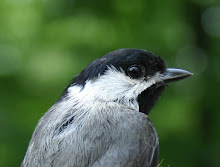I'll begin this post with a warning. This entry is not for those who are squeamish at the mere mention of bees and wasps. This isn't going to be a gory entry by any means, but I am going to delve into the life histories of the things that sting.
This entry was inspired by the sight of this house on a house.
This is the home of a Paper Organ Mud Dauber Wasp (Trypoxylon politum). These non-aggressive, solitary wasps belong to the Crabronidae family and this includes digger wasps and sand wasps, all considered "hunter wasps". The female wasp gathers mud and builds her nest, where she deposits an egg in each nest cell. The male wasp will guard the nest and mate with the female each time she returns to the nest to feed the larvae. Spiders are the primary food for the growing larvae.
Danno and I rarely use the front door as we enter the house through the garage. At some point (probably last summer, from the looks of the nest) a paper wasp created a nest on the frame of our front door. Yikes!
Paper Wasps are in the Vespidae family and the Hymenoptera order. (Bees and ants also belong in this order.) There are several species of paper wasps and all are social. An overwintering paper wasp emerges in spring and begins building a nest. A queen gathers fibers from dead limbs, exposed boards, paper litter and plant stems. In the next phase of building the female will gather water from puddles, bird baths or other shallow water sources. Then she will regurgitate that water to connect the paper fibers of the nest and create a waterproof coating on top. It's not long before the nest is buzzing with activity. The eggs hatch into larvae, which remain in this stage for about 2 weeks before entering the pupal stage. The queen then covers the developing pupae with more paper. The queen continues to build nest cells and lay eggs. Meanwhile, sterile females emerge 3 weeks later from the covered cells and finish building the other nest cells that the queen started, and assist in feeding the larvae and pupae while the queen continually lays eggs. Later in the summer, the queen will lay eggs from which fertile males and females will develop. Once this happens, the queen stops laying eggs, the sterile females stop working and the males and females mate and depart the nest. The males will die during the winter but the females survive to begin the cycle again in the spring.
Did you know that you can make a Bee Box?
The Ecology Center has scattered several bee boxes across the property. These boxes consist of blocks of wood with holes of varying sizes to attract a diversity of bees. These are made to attract solitary bees, who, unlike the society-minded bumblebees and honeybees, prefer to live alone. The Andrenidae and Halicitidae families are the largest solitary bee families. There are some minor behavioral differences between these families, but both nest in underground burrows. You can often find these nests in bare earth or sand. The entrances are usually the diameter of a pencil and it is not unusual to find the excavated earth piled up around the entrance. There are many types of bee boxes you can make and some are made to place either on or in the ground.
The houses from which these insects are raised are just one aspect of their fascinating stories. There are several books and websites to learn about our wasp and bee friends. I'm still a bit squeamish around the stingers, but the more I read, the less afraid I become and the more my respect grows for these insects. At the very least, I can tolerate their present and not freak out when they buzz in my direction.
Gifts
5 hours ago




Wow - I never knew! Solitary bees and bee boxes. This is why I love blogging.
ReplyDeleteVery interesting information. I don't mind bees but wasps scare the heck out of me! For some reason we seem to have more than our fair share of them this year. Not sure why?
ReplyDeleteSorry, but I plot the demise of your stingered little friends each spring. Just the paper wasps, though. The mud daubers are OK, even though they build their crusty nests in the most inopportune places, like on Farmer H's jacket that hangs on a nail in the garage.
ReplyDeleteThe paper wasps get in the house and freak out the boys. And me. I think twelve nests is too many to have on the porch. So I go on a killing spree. I'm sure they can find other places to build nests where I won't murder them.
I never go after the bees, either. But those wasps the length of my pinky finger are just too much.
This comment has been removed by the author.
ReplyDeleteMichaele - I love reading blogs from people who have different professions or live in a different part of the country for the same reason. You learn so much :)
ReplyDeleteGeezer - Me too. The bees I don't mind so much, but the wasps make me want to scream like a little girl. I think most animals/insects have abundant and lean years. For us this year we had an abundance of ants.
Hillbilly Mom - I will admit that I have killed paper wasps if they were on my bird nest boxes. This year I found a mud dauber nest in one of my nest boxes and about wet myself. I know they're good for keeping insect populations under control but they are not so understanding of me monitoring my birds.